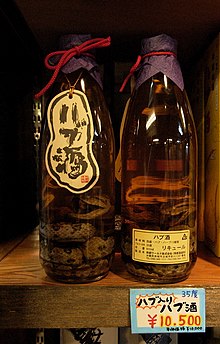Habushu: Difference between revisions
m spacing fix in intro, sm edits to tighten language |
No edit summary Tags: Mobile edit Mobile web edit |
||
| Line 1: | Line 1: | ||
[[File:habushu.jpg|thumb|[[Pit viper]]s immersed in a bottle of ''habushu''.]] |
[[File:habushu.jpg|thumb|[[Pit viper]]s immersed in a bottle of ''habushu''.]] |
||
[[File:Habu liqueur, awamori flavoured with snakes and herbs.jpg|thumb]] |
[[File:Habu liqueur, awamori flavoured with snakes and herbs.jpg|thumb]] |
||
{{nihongo|'''''Habushu'''''|ハブ酒}} is an ''[[awamori]]''-based [[liqueur]] made in [[Okinawa Prefecture|Okinawa]], [[Japan]]. Other common names include Habu Sake or Okinawan Snake Wine. Habushu is |
{{nihongo|'''''Habushu'''''|ハブ酒}} is an ''[[awamori]]''-based [[liqueur]] made in [[Okinawa Prefecture|Okinawa]], [[Japan]]. Other common names include '''Habu Sake''' or '''Okinawan Snake Wine'''. Habushu is named after the habu snake ([[Trimeresurus flavoviridis]]) which belongs to the [[pit viper]] family and is closely related to the [[rattlesnake]] and [[copperhead]]s.<ref>{{citation |last=Society for Science and the Public |title=Snakes from Okinawa |journal=The Science News-Letter |volume=48 |pages=211–212 |year=1945 |doi=10.2307/3922011}}</ref> Habu snakes are venomous and native to areas in Southeast Asia and other large island groups including the Philippines, Ryukyus, and Japan.<ref>{{cite web|url=http://www.fort.usgs.gov/resources/education/bts/bioeco/other_snakes.asp |title=Other Snakes of the South Pacific Most Likely to be Encountered |accessdate=2011-12-01}}</ref> A bite from a habu snake can cause nausea, vomiting, hypotension, and possibly death. There have been cases where victims report the loss of motor function in hands and legs following treatment.<ref>{{cite journal |
||
| authorlink = Aniya, Y., Heshiki, J., Ashitomi, I., Higa, K., & Matsusaki, C. |
| authorlink = Aniya, Y., Heshiki, J., Ashitomi, I., Higa, K., & Matsusaki, C. |
||
| title = An experimental study of emergency care for habu bites : estimation of amount of venom removed by suction. |
| title = An experimental study of emergency care for habu bites : estimation of amount of venom removed by suction. |
||
Revision as of 23:31, 26 April 2015


Habushu (ハブ酒) is an awamori-based liqueur made in Okinawa, Japan. Other common names include Habu Sake or Okinawan Snake Wine. Habushu is named after the habu snake (Trimeresurus flavoviridis) which belongs to the pit viper family and is closely related to the rattlesnake and copperheads.[1] Habu snakes are venomous and native to areas in Southeast Asia and other large island groups including the Philippines, Ryukyus, and Japan.[2] A bite from a habu snake can cause nausea, vomiting, hypotension, and possibly death. There have been cases where victims report the loss of motor function in hands and legs following treatment.[3]
The awamori is first mixed with herbs and honey giving the clear liquid a yellow hue. A pit viper is then inserted into the liquid and stored until consumed. Some brands of habushu come with the snake still inside the bottle.[4]
There are two methods of inserting the snake into the alcohol. The maker may choose to simply submerge the snake in the alcohol and seal the bottle, thus drowning the snake. Alternatively, the snake may be put on ice until it passes out, at which point it is gutted, bled and sewn up. When the viper is thawed and awakens, it will quickly die in an aggressive striking manner, which is what most producers look for. The manufacturer will then put the habu in an ethanol bath for a month to preserve it.[5] To continue the process, the habu is put in a 59% alcohol mix for 40 days and finally put in a 35% awamori mix to prepare for consumption. Removing the intestines of the snake, as in the second method, is thought to decrease the drink's particularly unpleasant smell.
A main distributor of habushu uses around 5,000 habu snakes per year. It is a very popular item amongst Americans in the military stationed in Japan.[citation needed] The distillery uses crushed rice and Koji mold to produce the awamori that goes into the habushu. It is a typical practice to age the awamori for a longer period. The alcohol helps the venom to dissolve and become non poisonous.[5]
Appreciated since ancient times, habushu is believed by some to have medicinal properties. A habu can go without eating anything for as long as a year and still have immense energy. Another desired trait that is thought to be passed on is the positive effect on the male libido. A habu snake is able to mate for as long as 26 hours, which causes some to believe that a drink of habushu may help sexual dysfunction in men.[6] It is thought that these strengths get passed on to those who drink habushu.
See also
References
- ^ Society for Science and the Public (1945), "Snakes from Okinawa", The Science News-Letter, 48: 211–212, doi:10.2307/3922011
- ^ "Other Snakes of the South Pacific Most Likely to be Encountered". Retrieved 2011-12-01.
- ^ "An experimental study of emergency care for habu bites : estimation of amount of venom removed by suction". Ryukyu Medical Association. 5 (3): 196–200. 1982.
- ^ "Saké Sunday: Saké With a Snake?". 2008-02-10. Retrieved 2008-08-19.
- ^ a b "Worm or Snake: Which do you prefer in your liquor?". 2007-08-15. Retrieved 2011-12-02.
- ^ "Habu Sake". Retrieved 2011-12-02.
